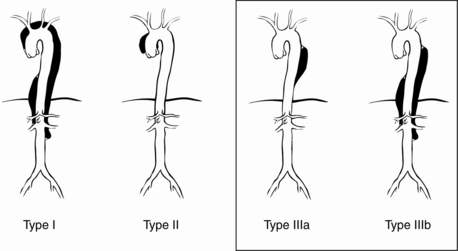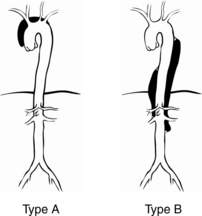Chapter 30 Aortic Dissection
3 Describe the DeBakey and Stanford classifications of aortic dissection
The DeBakey classification describes three types of dissection (Fig. 30-1):
 Type I: extends from aortic root to beyond the ascending aorta
Type I: extends from aortic root to beyond the ascending aorta
 Type II: involves only the ascending aorta
Type II: involves only the ascending aorta
 Type III: begins distal to the takeoff of the left subclavian artery and has two subtypes
Type III: begins distal to the takeoff of the left subclavian artery and has two subtypes
The Stanford classification has two types of dissection (Fig. 30-2):
 Type A: involves the ascending aorta
Type A: involves the ascending aorta
 Type B: involves the descending aorta, distal to the left subclavian artery
Type B: involves the descending aorta, distal to the left subclavian artery
5 What are the risk factors and associated conditions for dissection?
 Hypertension: Present in 70% to 90% of patients with acute dissection.
Hypertension: Present in 70% to 90% of patients with acute dissection.
 Advanced age: Mean of 63 years in the International Registry of Acute Aortic Dissection (IRAD).
Advanced age: Mean of 63 years in the International Registry of Acute Aortic Dissection (IRAD).
 Male sex: Represented by 65% of patients in the IRAD.
Male sex: Represented by 65% of patients in the IRAD.
 Family history: Recently recognized is a genetic, nonsyndromic familial form of thoracic aortic dissection. Studies of patients referred for repair of thoracic aortic dissections and aneurysms who did not have a known genetic mutation have indicated that between 11% and 19% of these patients have a first-degree relative with thoracic aortic disease.
Family history: Recently recognized is a genetic, nonsyndromic familial form of thoracic aortic dissection. Studies of patients referred for repair of thoracic aortic dissections and aneurysms who did not have a known genetic mutation have indicated that between 11% and 19% of these patients have a first-degree relative with thoracic aortic disease.
 Trauma (deceleration/torsional injury)
Trauma (deceleration/torsional injury)
 Congenital and inflammatory disorders: present as Marfan syndrome in almost 5% of total patients in the IRAD and half of those patients under age 40 years. Other associated congenital disorders include Ehlers-Danlos syndrome, Loeys-Dietz syndrome, bicuspid aortic valve, aortic coarctation, Turner syndrome, Takayasu and giant-cell aortitis, relapsing polychondritis (Behçet disease, spondyloarthropathies), or confirmed genetic mutations known to predispose to dissections (TGFBR1, TGFBR2, FBN1, ACTA2, or MYH11).
Congenital and inflammatory disorders: present as Marfan syndrome in almost 5% of total patients in the IRAD and half of those patients under age 40 years. Other associated congenital disorders include Ehlers-Danlos syndrome, Loeys-Dietz syndrome, bicuspid aortic valve, aortic coarctation, Turner syndrome, Takayasu and giant-cell aortitis, relapsing polychondritis (Behçet disease, spondyloarthropathies), or confirmed genetic mutations known to predispose to dissections (TGFBR1, TGFBR2, FBN1, ACTA2, or MYH11).
 Pregnancy: Associated with 50% of dissections in women under age 40 and most frequently occurring in the third trimester. This might be attributable to elevations in cardiac output during pregnancy that cause increased wall stress.
Pregnancy: Associated with 50% of dissections in women under age 40 and most frequently occurring in the third trimester. This might be attributable to elevations in cardiac output during pregnancy that cause increased wall stress.
 Circadian and seasonal variations: Producing a higher frequency of dissection in the morning hours and in the winter months.
Circadian and seasonal variations: Producing a higher frequency of dissection in the morning hours and in the winter months.
 Iatrogenic: Occurring as a consequence of invasive procedures or surgery, especially when the aorta has been entered or its main branches have been cannulated, such as for cardiopulmonary bypass.
Iatrogenic: Occurring as a consequence of invasive procedures or surgery, especially when the aorta has been entered or its main branches have been cannulated, such as for cardiopulmonary bypass.
6 Describe the common clinical signs and symptoms of aortic dissection
 Pain: The most common presenting symptom is chest pain, occurring in up to 90% of patients with acute dissection. Classically, for type A dissections, sudden onset of severe anterior chest pain with extension to the back occurs that is described as ripping or tearing in nature. However, in the IRAD, pain was more often described as sharp rather than ripping or tearing. The pain is usually of maximal intensity from its inception and is frequently unremitting. It may migrate along the path of the dissection. The pain of aortic dissection may mimic that of myocardial ischemia. Patients with type B dissections are more likely to be seen with back pain (64%) alone.
Pain: The most common presenting symptom is chest pain, occurring in up to 90% of patients with acute dissection. Classically, for type A dissections, sudden onset of severe anterior chest pain with extension to the back occurs that is described as ripping or tearing in nature. However, in the IRAD, pain was more often described as sharp rather than ripping or tearing. The pain is usually of maximal intensity from its inception and is frequently unremitting. It may migrate along the path of the dissection. The pain of aortic dissection may mimic that of myocardial ischemia. Patients with type B dissections are more likely to be seen with back pain (64%) alone.
 Syncope: Syncope is a well-recognized clinical feature of dissection, occurring in up to 13% of cases. Impairments of cerebral blood flow can be due to acute hypovolemia, low cardiac output, or dissection-involvement of the cerebral vessels. Patients with a presenting syncope were significantly more likely to die than were those without syncope (34% vs. 23%), likely because of the frequent correlation with associated cardiac tamponade, stroke, decreased consciousness, and spinal cord ischemia.
Syncope: Syncope is a well-recognized clinical feature of dissection, occurring in up to 13% of cases. Impairments of cerebral blood flow can be due to acute hypovolemia, low cardiac output, or dissection-involvement of the cerebral vessels. Patients with a presenting syncope were significantly more likely to die than were those without syncope (34% vs. 23%), likely because of the frequent correlation with associated cardiac tamponade, stroke, decreased consciousness, and spinal cord ischemia.
7 Describe the common clinical findings associated with aortic dissection
 Neurologic symptoms. The reported frequency of neurologic symptoms in pooled data of type A and B dissections approaches 17%; in type A alone, 29% of patients were seen initially with neurologic symptoms, 53% of which represented ischemic stroke. Neurologic complications may result from hypotension, malperfusion, distal thromboembolism, or nerve compression. Acute paraplegia as a result of spinal cord malperfusion has been described as a primary manifestation in 1% to 3% of patients. Up to 50% of neurologic symptoms may be transient.
Neurologic symptoms. The reported frequency of neurologic symptoms in pooled data of type A and B dissections approaches 17%; in type A alone, 29% of patients were seen initially with neurologic symptoms, 53% of which represented ischemic stroke. Neurologic complications may result from hypotension, malperfusion, distal thromboembolism, or nerve compression. Acute paraplegia as a result of spinal cord malperfusion has been described as a primary manifestation in 1% to 3% of patients. Up to 50% of neurologic symptoms may be transient.
 Cardiovascular manifestations. The heart is the most frequently involved end-organ in acute proximal aortic dissections.
Cardiovascular manifestations. The heart is the most frequently involved end-organ in acute proximal aortic dissections.
 Acute aortic regurgitation may be present in 41% to 76% of patients with proximal dissection and may be caused by widening of the aortic annulus resulting in incomplete valve closure or actual disruption of the aortic valve leaflets from the dissection flap. Clinical manifestations of dissection-related aortic regurgitation span from mere diastolic murmurs without clinical significance to overt congestive heart failure and cardiogenic shock.
Acute aortic regurgitation may be present in 41% to 76% of patients with proximal dissection and may be caused by widening of the aortic annulus resulting in incomplete valve closure or actual disruption of the aortic valve leaflets from the dissection flap. Clinical manifestations of dissection-related aortic regurgitation span from mere diastolic murmurs without clinical significance to overt congestive heart failure and cardiogenic shock.
Full access? Get Clinical Tree






